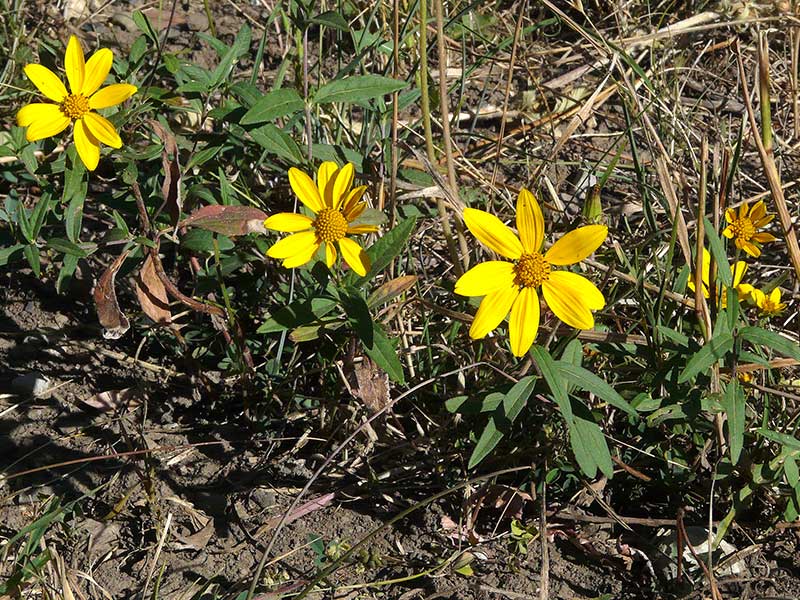Heliomeris multiflora / showy goldeneye
- a “Doggone” Yellow Composite (DYC) with 5-14 ray florets; golden dome of disc florets
- multi-stemmed perennial forms clumps
- often seen in profusion (but not always)
- long, thin, lanceolate to linear leaves; maybe with a few small teeth along the edges
- leaves have a strong midrib vein and distinct side veins
Also known as: little sunflower, many-flowered sunflower, mountain sunflower, rosinweed
Synonym: Viguiera multiflora
Showy goldeneye is a long-lived, herbaceous perennial, abundantly flowering in summer and fall, often brightening many acres with golden yellow. It mainly inhabits open, dry to moderately moist slopes and is very common along roadsides.
Showy goldeneye is multi-stemmed, the shoots developing from a branched, somewhat woody caudex. It also has a large taproot. Its bushy clumps stand up to 4 feet tall, although mostly shorter.
The flower heads are borne at the ends of the branches. Compared to, for example, common sunflower (Helianthus annuus), the goldeneye flowers are much more numerous and smaller, ca. 2 in in diameter. Each has 5 to 14 ray florets (“petals”) and around 50 disc florets. The ray petals have a small notch at the tip and faint lengthwise grooves. The central disk of florets looks quite green and dark when young and then quite golden-yellow when it matures. At that point, it also forms a distinct dome. The golden dome outlives the yellow ray florets which drop away.
Showy goldeneye leaves are perhaps the most distinctive feature of the plant. They are broadly to narrowly lance-shaped, slightly toothed, and 1 to 3 inches long. They have a strong midrib vein and less prominent but distinct side veins radiating towards the edges. All but the uppermost leaves are oppositely arranged on the stem.
Showy goldeneye is common along roadsides and on open, dry to moderately moist slopes (18 to 26 inches of rain per year). It is also common with sagebrush and along streams, near springs, in forest openings, and in shrub land, woodland, and forest understories. It’s fine with dry/mesic south facing slopes, but not with shaded; thus, you will find it in open aspen stands but not in closed ones.
Finally, as the Plant-of-the-Week on the USDA-FS site, this species received a very positive write-up, and the conclusion that “It is one plant that does not deserve being called just another DYC (doggone yellow composite).” [Often, another word is substituted for ‘doggone’].
| Color | |
|---|---|
| Family | |
| Blossom size | |
| Inflorescence size | |
| Inflorescence type | |
| When? | |
| Where? |

